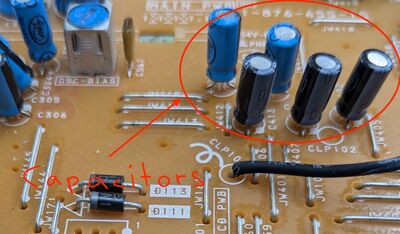Capacitors: Difference between revisions
No edit summary |
No edit summary |
||
| (5 intermediate revisions by the same user not shown) | |||
| Line 1: | Line 1: | ||
[[File:Electronic_components_capacitor.jpg|right|400px]] | [[File:Electronic_components_capacitor.jpg|right|400px]] | ||
Back to [[Electricity_and_Magnetism]] | |||
= Textbook = | = Textbook = | ||
*[https://openstax.org/books/university-physics-volume-2/pages/8-introduction University Physics Volume 2: Chapter 8 - Capacitance] | *[https://openstax.org/books/university-physics-volume-2/pages/8-introduction University Physics Volume 2: Chapter 8 - Capacitance] | ||
= What is a Capacitor and what is Capacitance = | = What is a Capacitor and what is Capacitance = | ||
| Line 64: | Line 65: | ||
* *C_1, C_2, \dots, C_n* are the individual capacitances (in farads, F) | * *C_1, C_2, \dots, C_n* are the individual capacitances (in farads, F) | ||
== Capacitor Discharge | == RC Circuits (Capacitor Discharge/Charging) (Voltage over Time) == | ||
See [[RC_Circuits]] | |||
| Line 113: | Line 96: | ||
<br class="clear"/> | <br class="clear"/> | ||
Back to [[Electricity_and_Magnetism]] | Back to [[Electricity_and_Magnetism]] | ||
<br class="clear"/> | |||
Next: [[Current and Resistance]] | |||
Latest revision as of 15:34, 22 November 2024

Back to Electricity_and_Magnetism
Textbook
What is a Capacitor and what is Capacitance
A capacitor is an electronic component that stores electrical energy in an electric field, created between two conductive plates separated by an insulating material (called a dielectric). Capacitance is the measure of a capacitor's ability to store charge per unit voltage, typically measured in farads (F).
Capacitors are widely used in various applications, including:
- **Energy storage** (e.g., in power supplies)
- **Filtering** (e.g., in electronic circuits to smooth out fluctuations in voltage)
- **Timing circuits** (e.g., controlling signal timing in oscillators)
- **Signal coupling and decoupling** (e.g., in audio equipment).
Their ability to store and release energy quickly makes them essential in electronics.
Formulas
Capacitance Definition
The capacitance C of a capacitor is defined as the ratio of the charge Q stored on one plate to the voltage V across the plates.
- Where:*
- *C* is the capacitance (in farads, F)
- *Q* is the charge (in coulombs, C)
- *V* is the voltage (in volts, V)
Capacitance of a Parallel Plate Capacitor
For a parallel plate capacitor, the capacitance depends on the area A of the plates, the separation d between them, and the permittivity ε of the dielectric material between the plates.
- Where:*
- *C* is the capacitance (in farads, F)
- *ε* is the permittivity of the dielectric material (in farads per meter, F/m)
- *A* is the area of one plate (in square meters, m²)
- *d* is the separation between the plates (in meters, m)
Energy Stored in a Capacitor
The energy E stored in a charged capacitor is proportional to its capacitance and the square of the voltage across it.
- Where:*
- *E* is the energy stored (in joules, J)
- *C* is the capacitance (in farads, F)
- *V* is the voltage (in volts, V)
Energy Density in a Capacitor
The energy density u represents the energy stored per unit volume in the electric field between the plates.
- Where:*
- *u* is the energy density (in joules per cubic meter, J/m³)
- *ε* is the permittivity of the material (in farads per meter, F/m)
- *E* is the electric field strength (in volts per meter, V/m)
Equivalent Capacitance in Series
For capacitors connected in series, the reciprocal of the total (or equivalent) capacitance is the sum of the reciprocals of the individual capacitances.
- Where:*
- *C_eq* is the equivalent capacitance (in farads, F)
- *C_1, C_2, \dots, C_n* are the individual capacitances (in farads, F)
Equivalent Capacitance in Parallel
For capacitors connected in parallel, the total capacitance is the sum of the individual capacitances.
- Where:*
- *C_eq* is the equivalent capacitance (in farads, F)
- *C_1, C_2, \dots, C_n* are the individual capacitances (in farads, F)
RC Circuits (Capacitor Discharge/Charging) (Voltage over Time)
See RC_Circuits
Videos
Capacitors
Capacitors in Series and in Parallel
Build your own capacitor
Simulations
- Charging And Discharging A Capacitor
- An Example Of A Natural Capacitor
- Factors Affecting Capacitance
- PhET Capacitor Lab Simulations
Other Links
Back to Electricity_and_Magnetism
Next: Current and Resistance